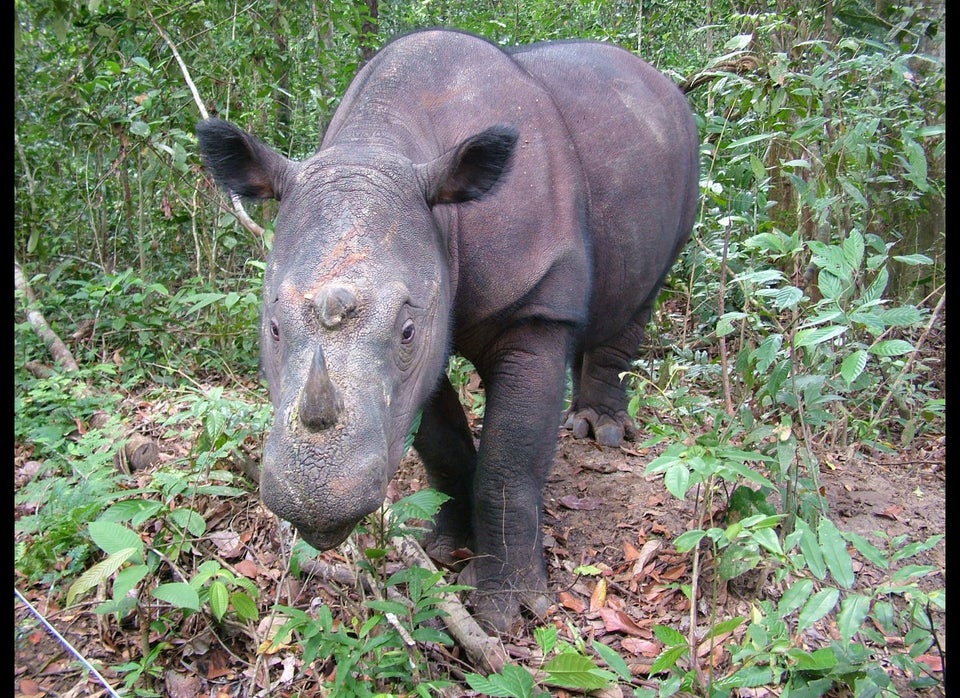
Across Africa, chimpanzee numbers have been plunging over the last few decades, as habitat loss, the bushmeat trade and diseases such as the Ebola virus and respiratory diseases transmitted by humans decimate chimp communities.
Chimps have "already disappeared from four African countries," the World Wide Fund for Nature writes, "and are nearing extinction in many others." In Côte d'Ivoire, for instance, a whopping 90 percent of a once-thriving population of chimps has vanished in the last 20 years.
But this month, amid the bleakness, has come a welcome ray of hope.
According to a new study published in the journal Biological Conservation, researchers have discovered a previously unknown and totally flourishing, "mega-culture" of Eastern chimpanzees in the remote forests of the Democratic Republic of Congo.
The authors of the study said that the group of chimps is likely the biggest in Africa and "may represent the largest continuous viable population of this subspecies" in the world. The researchers estimate the group is comprised of thousands -- if not tens of thousands -- of individuals that share a unique set of customs and behaviors across a vast swath of land.
"This population of chimpanzees is extremely important, as they form what appears to be a large, continuous population spread out over [an area of at least 50,000 square kilometers]," study co-author and primatologist Cleve Hicks of the Max Planck Institute in Leipzig, Germany, told The Huffington Post in an email this week.
"Fascinatingly, we found that these chimpanzees share similar behaviors across a huge area: they make a lot of ground nests, like gorillas, they pound open termite mounds, fruits and giant snails on buttresses and they use very long tools (up to 2.5 meters) to dip for ants," he added.
This incredible clip shows a mother chimpanzee in the Bili Forest using and transporting tools, and passing that tool-use expertise on to her child.
Hicks, who is also one of the directors of the great ape conservation group the Lukuru Foundation, said he and his colleagues first discovered this ape mega-culture in 2004 while conducting exploratory reconnaissance walks looking for chimps in the Bili-Gangu region.
The chimps in this region had previously been undocumented by researchers, Hicks said, so the finding of such a huge population of chimps -- particularly a group of "fearless chimpanzees who would not flee in terror at [the researchers'] approach" as they had not been exposed to hunters -- was an especially heartening one.
Better still, Hicks said that when he and his colleagues returned in 2012 to survey the chimps again, they were thrilled to find that the population had seemingly remained relatively stable.
However, despite the good news, the study's authors warn that this positive scenario may not last for long. For one thing, the chimps are currently unprotected and are vulnerable to human encroachment.
"The Bili region is officially protected but on paper only," Hicks told the HuffPost. "Elephants have already taken a big hit from poachers there [and] although the chimpanzee population remains stable, this can change rapidly. Time is ticking."
Troublingly, there's already been evidence that bushmeat hunters (who, as of 2010, have been estimated to kill about 440 chimpanzees every year in the northern part of the country alone) have started going deeper and deeper into the country's remote forests to find their precious quarry.
“Increasing numbers of bushmeat carcasses and chimpanzee orphans were found in Bili and nearby areas," said Christophe Boesch, one of the study's co-authors and director of the Department of Primatology at the Max Planck Institute, according to a recent media release. “Without proper protection these chimpanzees may succumb to the same factors that are eliminating populations of the species elsewhere."

Woman selling monkey meat in a market in Kisangani, Democratic Republic of Congo in April 15, 2004. According to WWF, over a million tons of bushmeat are consumed in the Democratic Republic of the Congo each year.
Researchers also told the Guardian that the area is at "great risk of being opened up," as regional militia -- such as Joseph Kony's Lord's Resistance Army -- begin to establish bases in the region. "I think the military are giving guns to the poachers," Hicks told the news outlet.
Ultimately, what the chimps desperately need, the researchers say, is real and reliable protection from the looming risks.
Gang of male chimps in the Bili Forest. "I never thought we would see the day when we would be able to capture 'slice of life' films of the Bili chimpanzees," wrote Hicks in a YouTube comment of the wonderfully intimate clip.
The researchers said their study should be seen as an important learning lesson to those interested in protecting endangered animals. They said environmentalists need to pick up the pace in finding and documenting the populations of endangered creatures, like the great apes, in all corners of the globe, as it is the only way the animals can be properly monitored and protected.
In countries like the Democratic Republic of the Congo, believed to be home to about half of the world's remaining chimpanzees, "achieving a better understanding of the distribution and density of the apes...should be a top priority," the researchers said.
As Jane Goodall wrote in her 2010 plea for the chimps: "There is no time to waste."
In the video below, watch as a majestic Bili chimpanzee saunters through the forest. To find out how you can help the chimps of the Democratic Republic of the Congo, visit the websites of the Lukuru Foundation, the Jane Goodall Institute and the Congolese Wildlife Authority.

